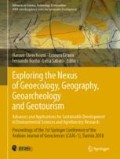Abstract
The aeolian sediments (mobile sand and dust) trapped along native plants create a geomorphological landform, known as nabkhas. About 600 core samples from aeolian accumulations settled around 15 species of main native plants in Kuwait. Cyperus conglomeratus, Haloxylon salicornicum and Rhanterium epapposum nabkha sediment is characterized by more alkaline (pH) values, low moisture content and electrical conductivity (EC). The later plants contain short branches spacing and are at close distances from the nearby nabkhas. The Astragalus sp. nabkhas mean grain sizes are considered the finest and contain considerable carbonate percentages as it grows in playa and alluvial fan deposits. Citrulus sp. nabkhas are characterized by the lowest pH, EC, and moisture content but the highest content of carbonate in comparison to other native plants. Lycium sp. has the longest distance between branches and to the equivalent nearby species. The maximum aeolian accumulation volume was noted around Nitraria retusa, Lycium shawii, Haloxylon salicornicum and Calligonum polygonoides up to 21.9, 15.5, 14.5, and 13.3 m3, respectively, which spot them as the most effective solutions for future applications in controlling aeolian activities in the region. This study aimed to assess the sediment properties around native plants and detect the most efficient plants in controlling aeolian activities in Kuwait.
Access this chapter
Tax calculation will be finalised at checkout
Purchases are for personal use only
References
Ahmed, M., Al-Dousari, N., Al-Dousari, A.: The role of dominant perennial native plant species in controlling the mobile sand encroachment and fallen dust problem in Kuwait. Arab. J. Geosci. 9(2), 134 (2015). https://doi.org/10.1007/s12517-015-2216-6
Al-Awadhi, J.M., Al-Dousari, A.M.: Morphological characteristics and development of coastal nabkhas, North-East Kuwait. Int J Earth Sci. (Geol Rusdsch) 102, 949–958 (2013). https://doi.org/10.1007/s00531-012-0833-9
Al-Dousari, A., Doronzo, D., Ahmed, M.: Types, indications and impact evaluation of sand and dust storms trajectories in the Arabian Gulf. Sustainability 9(9), 1526 (2017). https://doi.org/10.3390/su9091526
Al-Dousari, A., Misak, R., Shahid, S.: Soil compaction and sealing in Al Salmi area. J Land Degradation Dev 11, 401–418 (2000). https://doi.org/10.1002/1099-145X(200009/10)11:5%3c401:AID-LDR396%3e3.0.CO;2-4
Al-Dousari, A.M., Aba, A., Al-Awadhi, S., Ahmed, M., Al-Dousari, N.: Temporal and spatial assessment of pollen, radionuclides, minerals and trace elements in posited dust within Kuwait. Arab. J. Geosci. 9, 95 (2016). https://doi.org/10.1007/s12517-015-2182-z
Al-Dousari, A.M., Ahmed, M., Al-Senafy, M., Al-Mutairi, M.: Characteristics of nabkhas in relation to the dominant perennial plant species in Kuwait. Kuwait J. Sci. Eng. 35(1), 129–150 (2008)
Al-Dousari, A.M., Al-Awadhi, J.: Dust fallout in northern Kuwait, major sources and characteristics. Kuwait J. Sci. Eng. 39(2A), 171–187 (2012)
Al-Dousari, A.M., Pye, K.: Mapping and monitoring of dunes in northwestern Kuwait. Kuwait J. Sci. Eng. 32(2), 119–134 (2005)
Alghamdi, A.A., Al-Kahtani, N.S.: Sand control measures and sand drift fences. J. Perform. Constructed Facil. 19(4), 295–299 (2005). https://doi.org/10.1061/(ASCE)0887-3828
Al-Obaid N.: Economic and environmental assessment for direct and indirect factors causing desertification (base study in Bushra-Syria). The Arab Center for the Studies of Arid zones, Syria (2000)
Burri, K.: Plant and mycorrhizal Fungi in wind erosion control. Ph.D. Dissertation, Swiss Federal Institute of Technology in Zurich (ETH Zurich) (2011)
Cooke, R.U., Warren, A., Goudie, A.S.: Desert Geomorphology, pp. 357. Taylor & Francis, London (1993). ISBN 1-85728-017-2
Darwish, K., Safaa, M., Momou, A., Saleh, S.A.: Egypt: Land degradation issues with special reference to the impact of climate change. In: Heshmati, A.G., Squires, R.V. (eds.) Combating desertification in Asia, Africa and the Middle East: Proven practices, pp. 113–136. Springer, Netherlands, Dordrech (2013)
Djibril, H.: Desert environments of republic od chad. In: Heshmati, A.G., Squires, R.V. (eds.) Combating desertification in Asia, Africa and the Middle East: Proven practices, pp. 169–189. Springer, Netherlands, Dordrech (2013)
El-Wahab, R.A., Al-Rashed, A.R., Al-Dousari, A.: Influences of physiographic factors, vegetation patterns and human impacts on aeolian landforms in arid environment. Arid Ecosyst. 8(2), 97–110 (2018)
Fadhil, A.M.: Sand dunes fixation in Baiji, Iraq. J. China Univ Geosciences 13(1), 67–72 (2002)
Hammouzaki, Y.: Desertification and its control in Morocco. In: Heshmati, A.G., Squires, R.V. (eds.) Combating Desertification in Asia, Africa and the Middle East: Proven practices, pp. 91–110. Springer, Netherlands, Dordrech (2013)
Hong, S.H., Lee, E.Y.: Restoration of eroded coastal sand dunes using plant and soil-conditioner mixture. Int. Biorem. Biorem. 113, 161–168 (2016). https://doi.org/10.1016/j.ibiod.2016.04.021
Khalaf, F.I., Misak, R., Al-Dousari, A.M.: Sedimentological and morphological characteristics of some nabkha deposits in the northern coastal plain of Kuwait Arabia. J. Arid Env. 29(3), 267–292 (1995). https://doi.org/10.1016/S0140-1963(05)80107-7
Pahlavanravi, A., Miri, A., Ekhtesasi, M.R.: The impact of different kinds of dust storms in hot and dry climate, a case study in Sistan region. Desert 17(1), 15–25 (2012). http://jdesert.ut.ac.ir
Acknowledgements
Gratitude for supporter (KISR) Grant number: 2011/EC085C. Appreciation is extended to Abu Noor, Mamdouh and Sayed for their helping with laboratory and field measurements.
Author information
Authors and Affiliations
Corresponding author
Editor information
Editors and Affiliations
Rights and permissions
Copyright information
© 2019 Springer Nature Switzerland AG
About this paper
Cite this paper
Al-Dousari, A., Ahmed, M., Al-Dousari, N., Al-Awadhi, S. (2019). Nabkha Morphometry and Properties of Aeolian Sediments Around Native Plants in Kuwait. In: Chenchouni, H., Errami, E., Rocha, F., Sabato, L. (eds) Exploring the Nexus of Geoecology, Geography, Geoarcheology and Geotourism: Advances and Applications for Sustainable Development in Environmental Sciences and Agroforestry Research. CAJG 2018. Advances in Science, Technology & Innovation. Springer, Cham. https://doi.org/10.1007/978-3-030-01683-8_9
Download citation
DOI: https://doi.org/10.1007/978-3-030-01683-8_9
Published:
Publisher Name: Springer, Cham
Print ISBN: 978-3-030-01682-1
Online ISBN: 978-3-030-01683-8
eBook Packages: Earth and Environmental ScienceEarth and Environmental Science (R0)

